
Learn the ins-and-outs of a nice selection of measuring tools (and tricks to using them) as David Lyell gives a tour of I Can Do That Measuring Hacks. In the second part of our I Can Do That Workbench series, we build the torsion box top. It features a replaceable hardboard top surface and an affordable quick-action face vice.
11) Use tape if needed ‘ There are times when a clamp just won’t work. Perhaps a table you’ve created in the past is hit with something heavy on the edge and a small piece cracks or splinters off? Odds are, a clamp won’t hold the piece in the exact spot you need it.
This made absolutely no sense; I had made tens if not hundreds of these stools by this point and there was nothing different about my process to making them. I was shipping these custom stools within hours of receiving an order, while still holding a full time job. I would come home from work, visit with the family for a bit, then rush downstairs to fulfill orders I received throughout the day. Vise to a workbench, I attached it to scrap plywood so I can clamp it wherever I need it. Mark the vise-mounting holes on the plywood and drill 3/4-in. Recess the nut by drilling through the bottom sheet with a 1-in.
Woodworking is a rewarding and fulfilling hobby, but it can also be overwhelming for beginners who may have unrealistic expectations about what they can accomplish right out of the gate. Here are some tips to help new woodworkers take it slow and temper their expectations:
One is to make more time in general, while the other is to make more with the time you already have. Combine both of these together, and you have a recipe for a lot more productive shop time. Being able to use a handsaw is one of the most valuable skills a woodworker can have.
Start with Simple Projects
These aren’t just quick woodworking classes that resemble what you can find for free on YouTube! These are 2+ hour courses taught by professional woodworkers with excellent production value. With that out of the way, let’s have a look at the best woodworking classes online, starting with a few excellent courses from a platform you may never have even heard of. Quick builds and IKEA hacks are one thing, but if you really want to take your furniture-making skills to the next level, you need to invest in some woodworking classes. Periodically check and adjust the squareness of your table saw blade, miter saw, and other tools to ensure they are at a perfect 90-degree angle to the table or fence. This maintenance ensures your cuts are truly square.
One of the biggest mistakes that new woodworkers make is diving into complex projects before they have mastered the basics. Encourage beginners to start with simple projects like a cutting board or a basic bookshelf. This will help them build confidence and develop their skills before moving on to more challenging projects.
Practice Patience
Woodworking is a skill that takes time to develop. Encourage new woodworkers to be patient with themselves and not get discouraged if their first few projects don’t turn out perfectly. Remind them that every mistake is an opportunity to learn and improve their skills.
Take Breaks
Woodworking requires a great deal of focus and concentration, which can be mentally and physically exhausting for beginners. Encourage new woodworkers to take breaks when they start to feel frustrated or overwhelmed. Stepping away from a project for a few minutes can help clear the mind and prevent mistakes.
Seek Guidance
There is a wealth of information available to new woodworkers, including books, online tutorials, and woodworking classes. Encourage beginners to seek guidance from experienced woodworkers and take advantage of resources that can help them develop their skills.
FAQs
Q: How long does it take to become a skilled woodworker?
A: Developing woodworking skills takes time and practice. It’s important for new woodworkers to be patient and persistent in their learning journey.
Q: What tools do I need to get started in woodworking?
A: To get started in woodworking, beginners will need basic tools such as a saw, a hammer, measuring tape, and sandpaper. As they progress, they can invest in more specialized tools.



